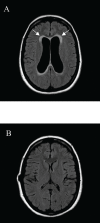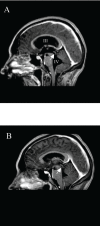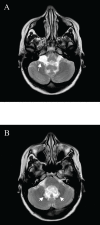Hydrocephalus, a rare manifestation of sarcoidosis
- PMID: 24765327
- PMCID: PMC3981377
- DOI: 10.4081/cp.2011.e66
Hydrocephalus, a rare manifestation of sarcoidosis
Abstract
A 36-week-pregnant woman developed a symptomatic hydrocephalus. Chest imaging showed bihilar lymphadenopathy and histological examination of a mediastinal lymph node revealed non-caseating granulomas. After delivery, her neurologic complaints progressed. Placement of a ventriculoperitoneal drain (VPD) did not reduce the symptoms. However, steroids resulted in rapid disappearance of the hydrocephalus. Hydrocephalus is a very rare manifestation of sarcoidosis. The diagnosis relies on the ability of clinicians to recognize this disorder. This case shows how a difference in opinion of the several specialists involved can lead to a delay in diagnosis and treatment.
Keywords: hydrocephalus; neurosarcoidosis.; sarcoidosis.
Figures



Similar articles
-
Hydrocephalus as the first presenting symptom of neurosarcoidosis in two patients: a diagnosis more forthcoming in the context of systemic disease.BMJ Case Rep. 2019 Aug 4;12(8):e229903. doi: 10.1136/bcr-2019-229903. BMJ Case Rep. 2019. PMID: 31383680 Free PMC article.
-
Hydrocephalus with panventricular enlargement as the primary manifestation of neurosarcoidosis: a case report.J Med Case Rep. 2013 Oct 14;7:240. doi: 10.1186/1752-1947-7-240. J Med Case Rep. 2013. PMID: 24124650 Free PMC article.
-
Sarcoidosis Presenting as Cranial Multinevritis.J Med Cases. 2021 Mar;12(3):112-114. doi: 10.14740/jmc3635. Epub 2021 Jan 19. J Med Cases. 2021. PMID: 34434440 Free PMC article.
-
Propionibacterium acnes-associated neurosarcoidosis: A case report with review of the literature.Neuropathology. 2018 Apr;38(2):159-164. doi: 10.1111/neup.12411. Epub 2017 Aug 30. Neuropathology. 2018. PMID: 28856748 Review.
-
[Hydrocephalus Mimicking Idiopathic Normal Pressure Hydrocephalus as the First Manifestation of Neurosarcoidosis].Brain Nerve. 2016 Dec;68(12):1477-1482. doi: 10.11477/mf.1416200619. Brain Nerve. 2016. PMID: 27916758 Review. Japanese.
Cited by
-
Clinical characteristics and outcome of hydrocephalus in neurosarcoidosis: a retrospective cohort study and review of the literature.J Neurol. 2022 May;269(5):2727-2733. doi: 10.1007/s00415-021-10882-2. Epub 2021 Nov 7. J Neurol. 2022. PMID: 34743227 Free PMC article.
-
Overcoming the Elusiveness of Neurosarcoidosis: Learning from Five Complex Cases.Neurol Int. 2021 Mar 25;13(2):130-142. doi: 10.3390/neurolint13020013. Neurol Int. 2021. PMID: 33805852 Free PMC article.
-
Diagnostic delay of sarcoidosis: an integrated systematic review.Orphanet J Rare Dis. 2024 Apr 11;19(1):156. doi: 10.1186/s13023-024-03152-7. Orphanet J Rare Dis. 2024. PMID: 38605384 Free PMC article.
-
Hydrocephalus as the first presenting symptom of neurosarcoidosis in two patients: a diagnosis more forthcoming in the context of systemic disease.BMJ Case Rep. 2019 Aug 4;12(8):e229903. doi: 10.1136/bcr-2019-229903. BMJ Case Rep. 2019. PMID: 31383680 Free PMC article.
-
Hydrocephalus as the presenting symptom of sarcoidosis: A case report and review of literature.Clin Case Rep. 2020 Jan 14;8(2):363-368. doi: 10.1002/ccr3.2665. eCollection 2020 Feb. Clin Case Rep. 2020. PMID: 32128190 Free PMC article.
References
-
- Spencer TS, Campellone JV, Maldonado I, et al. Clinical and magnetic resonance imaging manifestations of neurosarcoidosis. Semin Arthritis Rheum. 2004;34:649–61. - PubMed
-
- Lower EE, Broderick JP, Brott TG, et al. Diagnosis and management of neurological sarcoidosis. Arch Intern Med. 1997;157:1864–8. - PubMed
-
- Akhondi H, Barochia S, Holmström B, Williams MJ. Hydrocephalus as a presenting manifestation of neurosarcoidosis. Southern Med J. 2003;96:403–6. - PubMed
-
- Benzagmout M, Boujraf S, Góngora-Rivera F, et al. Neurosarcoidosis which manifested as acute hydrocephalus: diagnosis and treatment. Intern Med. 2007;46:1601–4. - PubMed
Publication types
LinkOut - more resources
Full Text Sources

